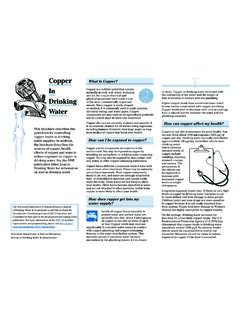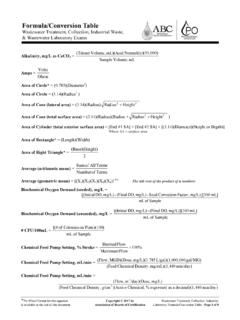Transcription of Rick Mealy State Laboratory of Hygiene pH Alkalinity Hardness
1 Rick Mealy George Bowman Program Chemist Inorganics Manager WI SNR - Lab Certification State Laboratory of Hygiene pH. (608) 264-6006 (608) 224-6279. Alkalinity Hardness Importance of General Chemistry Relationships in Water Treatment pH. Carbonate Chemistry Alkalinity Hardness Effective Disinfection Basic chlorine systems Alternative disinfection Arsenic Chemistry Treatment Session Discussion Topics 1. pH What is it pH and temperature How is it measured Not as simple as you might think pH is the term used universally to express the intensity of the acidity of a solution. More precisely, acids are defined as those compounds that release a proton (H+, hydrogen ion) whereas bases are those compounds that accept protons.
2 Thus, pH is the measurement of hydrogen ion (H+) activity. Pure water dissociates to yield equivalent concentrations of hydrogen [H+] and hydroxide [OH-] ions: H2O H+ + OH- The equilibrium for pure water is [H+] [OH-] = Kw = 10-14. =10-7 10-7. Therefore at equilibrium, [H+] = [OH-] = 10-7 = pH of 7. The scale ranges from 0 to 14 [H+] = 10 0 to 10-14. What is pH? 2. pH scale pH = "potential Hydrogen" ion concentration pH is usually expressed as log 1 / [H+] or log [H+]. pH tells us whether a solution is acid, alkaline or neutral and relative acidity. It does not tell us how much acid or alkali is present. pH is a critical measurement. Life depends upon it.
3 For instance, human blood is basic with a pH. between and If the blood pH drops < , acidosis occurs (diabetes). If blood pH rises > , alkalosis occurs (Tums OD). Below and above 7,8, death occurs One unit in pH equals a 10x change in acidity. Two units means 100 times change, 3 units is 1000 times and so on. pH. 3. ** [OH-] concentration ** ** [H+] concentration **. (mol/L) ____(mg/L)____ pH (mg/L) ___ _(mol/L)_. 1 x 10-14 0 10000 1 x 100. 1 x 10-13 1 1000 1 x 10-1. 1x 10-12 2 100 1 x 10-2. 1 x 10-11 3 10 1 x 10-3. 1x 10-10 4 1 x 10-4. 1 x 10-9 5 1 x 10-5. 1x 10-8 6 1 x 10-6. 1 x 10-7 7 1 x 10-7. 1x 10-6 8 1 x 10-8. 1x 10-5 9 1 x 10-9. 1 x 10-4 10 1 x 10-10.
4 1x 10-3 10 11 1 x 10-11. 1 x 10-2 100 12 1 x 10-12. 1x 10-1 1000 13 1 x 10-13. 1 x 100 10000 14 1 x 10-14. H+ concentration table another view pH is a measure of the available hydrogen ions (H+). pH is calculated as the negative log of the H+. concentration - log [H+]. pH of n = a H+ concentration of 1 x 10 -n pH describes a water's relative acidity, provides no measure of how the water will tolerate addition of acid or base to the system. pH is measured according to electrometric principles based on the Nernst equation. Temperature is the only variable. pH affects nearly every water and wastewater treatment function (wherever some chemistry is involved).
5 PH - what you need to know 4. Carbonate Chemistry Surface Water system CO2. Photosynthesis & CO2 aq. H2CO3 Carbonic acid Respiration (CO2 + H20). Bicarbonate HCO3 + H+. Alkalinity Mg2+ Na+. K+ Ca2+ Carbonate CO 2- + H+. 3. Hardness CaCO3. The Carbonate Cycle - Surface Water 5. CO2 Rainwater picks up CO2. from the atmosphere. CO2 As the water seeps into the soil, further CO2-- produced from decaying plants or respiration--is Un-Saturated Zone picked up. Decaying vegetation CO2. The reaction of water Limestone= CaCO3. and CO2 yields carbonic Dolomite= CaMg(CO3)2. acid--a weak acid. CO2 + H2O H2CO3 . The weak acid dissolves limestone and Saturated Zone H2O dolomite allowing the + water to pick up Ca+2 calcium, magnesium Mg+2.
6 CO3= and carbonate ions. HCO3- How CO2 enters groundwater When carbon dioxide enters the water: CO2 (air, decaying OM) CO2 (dissolved) + H2O. Some of the dissolved CO2 hydrates (reacts with water) to from carbonic acid (H2CO3 ): CO2 + H2O H2CO3. Carbonic acid will dissociate: H2CO3 HCO3- + H+. Forming bicarbonate and a free hydrogen ion HCO3- CO32- + H+. Bicarbonate further dissociates: to carbonate and a free hydrogen ion CO2 reactions 6. CO2 input (respiration). (produces H+, decreases pH, more acidic). pH. Carbonic Acid Bicarbonate Carbonate CO2 + H2O H2CO3 HCO3- + H+ CO32- +2 H+. pH. CO2 removal by photosynthesis (removes H+, increases pH).
7 Biological processes & pH. Flux of carbon dioxide (CO2) and it's influence on pH. CO2. photosynthesis respiration (pH ) CO2 CO2 + CO2. (pH ). Carbon dioxide not only dissolves in water, it reacts with it. CO2 and pH influence 7. These reactions get a bit more complicated: Also have reactions that result in the formation of the hydroxyl ion: Bicarbonate Carbonic acid HCO3- + H2O H2CO3 + OH- Carbonate Bicarbonate CO32- + H2O HCO3- + OH- Further consideration: OH- Which form of carbon will dominate? ..depends on the pH. Carbon form vs. pH. 8. Lakes/reservoirs (many western states ) that have a lot of carbonate can resist changes in pH with the addition of acids Ability to resist changes in pH with respect to the addition of acid is called Alkalinity or Acid neutralizing capacity (ANC).
8 The Buffer System The carbonate system is dynamic The main formula is: CO2 + H2O H2CO3 HCO3- + H+ CO32- +2 H+. Additions or reductions to any one side of the reaction will shift the reaction the opposite direction Respiration & photosynthesis affect this reaction by addition of or removal of CO2. Addition of CO2 reduces the pH of a system Removal of CO2 increases the pH of a system Carbon Cycle - What you need to Know 9. Alkalinity . what is it? how is it measured? same as Hardness ? Alkalinity affects on pH. changes (treatment). acidity- Alkalinity -pH chart Alkalinity is a total measure of the substances in water that have "acid-neutralizing" ability.
9 Alkalinity indicates a solution's power to react with acid and "buffer" its pH -- that is, the power to keep its pH from changing. while pH measures the strength of an acid (base), Alkalinity measures the ability to neutralize acid (base). Mathematically, Alkalinity can be determined by: Alkalinity = [HCO3-] + 2[CO32-] + [OH-] [H+]. Alkalinity provides a buffering capacity to aqueous system. The higher the Alkalinity is, the higher the buffering capacity against pH changes. What is Alkalinity ? 10. Alkalinity essentially becomes a measure of the buffering capacity of the Carbonate/Bicarbonate ions --- and to some extent---the hydroxide ions of water.
10 These 3 ions all react with H+ ions to reduce acidity, increasing Alkalinity & pH. HCO3- + H+ CO2 + H2O. CO3-2 + H+ HCO3. OH- + H+ H2O. Alkalinity - closer look 50 ppm Total Alkalinity Neutralization with H2SO4. HUGE pH. change with minimal acid addition [. Compare the neutralization of NaOH to that of Na2CO3. If trying to control the pH of a process around pH=7. Virtually impossible to use NaOH as the base SHARP inflection point (drop) of titration curve occurs pH to 9. Alkalinity and NaOH neutralization 11. 100. 90. 80. 70. % Composition 60. HCO3- CO3= HCO3- 50 CO3=. -------- ------ OH- 40 CO3= OH- 30. 20 P = Phenolphthalein Alkalinity 10 T = Total Alkalinity 0.]










